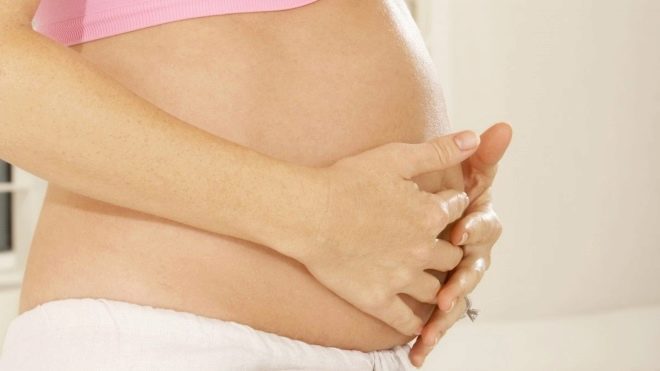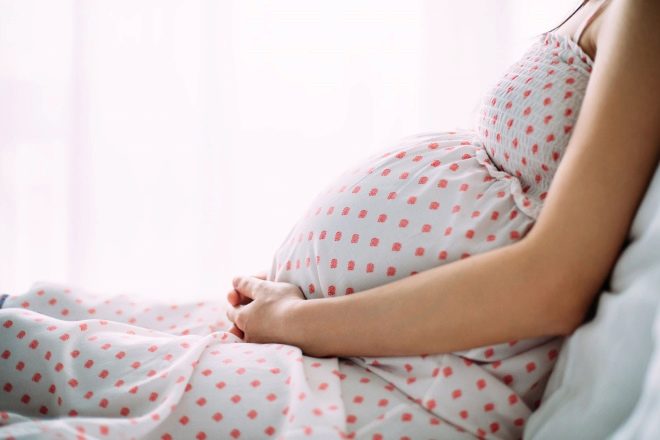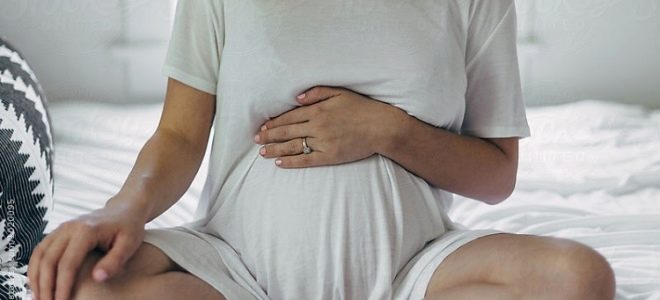Second trimester of pregnancy
Recommendations to closely monitor the nature of vaginal discharge during pregnancy, women do not just like that, because this symptom is often the first, and sometimes the only symptom of possible complications. Vaginal secretions - physiological environment, which is necessary for self-cleaning of the genital tract, to maintain their condition.
The secretions consist of the secretion of the cervix of the uterus and the substances that the vaginal mucosa secretes. With any violation in the course of pregnancy in the second trimester, the nature of the discharge will begin to change.
Normal
In the first trimester, the female body experiences complex adaptation processes; under the influence of huge doses of progesterone, the discharge is usually scanty. Often they are called "dry" or "semi-dry" period. Therefore, in the second trimester, expectant mothers have a lot of questions about why the selection has become different. For the second trimester, an increase in the amount of vaginal secretion is characteristic. This means that there are more secretions., and this fact itself should not frighten a woman.
Most abundant discharge become by 23-25 weeks of pregnancy, and this is in a certain way connected with the hormonal processes that occur in the future mother's body, as well as with an increase in the amount of blood circulating in her body. It is by the 24th week that the amount of blood in the woman’s body becomes maximal, the placenta is working at full capacity, creating, in fact, an extra circle of blood circulation - the uteroplacental.
The fetus in the uterus is protected not only by the fetal membranes, waters, and placenta. The mucus plug blocking the cervical canal of the cervix, which connects the vagina and the uterine cavity, also protects it from the penetration of microbes and viruses into the uterus. Strengthening the secretion of the cervix and vagina in the second trimester is another protective reaction, because a normal, healthy microenvironment of vaginal secretions is an obstacle for many disease-causing organisms.
The amount of discharge increases in all pregnant women in the middle of the gestation period. In some, the discharge does not cause significant anxiety and inconvenience, in others because of the constant feeling of moisture in the perineum, there is noticeable discomfort.
The amount of discharge is individual, and to compare it in one woman with the amount of secretion of another is a hopeless exercise.
It is important to know that normal second trimester discharge has the following signs:
- they are homogeneous in consistency, do not have clots, inclusions, impurities, lumps;
- in color - light, whitish or transparent, a slight yellowish shade is allowed due to the effects of progesterone;
- the smell is absent or there is an unexpressed light smell resembling kefir;
- even heavy discharge does not cause itching, discomfort in the perineum, redness.
The presence of whiter is allowed, again not delivering any discomfort to the woman.
As you approach the end of the second trimester, the excretions become more fluid, and this is normal. So the pregnant woman's body is preparing for childbirth, clearing the genital tract in advance before this important process.
In the second trimester, any other discharge, with blood or mucus, with clots is considered abnormal..
Let's look at what can say the selection, which is different from the norm.
Whites
Beli themselves are different.
- If there were thick and heterogeneous, very abundant leucorrhoea with an admixture of watery character, it can be manifestations of tubular leucorrhoea, which occur during inflammation of the fallopian tubes. The situation in the second trimester is rare, but it can happen.
- Whitish with mucus called cervical, they usually occur with infections that have struck the cervix.
- Abundant vaginal leucorrhoea with blood or purulent patches They talk about the inflammatory process in the shell of the vagina. If whites began to resemble cottage cheese, itching and the smell of yeast appeared - this is a thrush that can also manifest itself in the second trimester of pregnancy against the background of reduced immunity.
Thrush (candidiasis) must be treated.
- Highlight white, abundant and liquid, translucentwhich are intensified after a woman spends some time in a state of rest in a horizontal position, they can say that the integrity of the fetal membranes is violated and water began to leak. No need to panic. Modern medicine has many opportunities to maintain a pregnancy even in such a situation - you just need to call an ambulance and get into the hospital as soon as possible. A woman is shown to stay in a sterile chamber, a change of gaskets every 3 hours, strict bed rest. She will be given drugs with tocolytic action. There is a high probability that damaged amniotic membranes will be able to contract and their integrity will be restored.
- Thick white discharge without itching, heterogeneous in their consistency, may indicate the presence of an allergic reaction to soap, intimate hygiene products, gaskets, lubricant-lubricants that the couple uses during sexual intercourse, as well as certain types of food. It is important to find the cause of the allergy and eliminate it.
Violation of the consistency or amount of white discharge in the second trimester may be a consequence of the future mother’s great love of douching.
Brown
Highlighting of this color cannot be the norm in the second trimester under any circumstances. Their appearance in combination with an increased uterine tone for a period of up to 22 weeks indicates a threat of late miscarriage, and after 22 weeks, a threat of premature birth.
Spotting brown secretions are most often caused by a deficiency of progesterone in the body of the future mother, there are also other reasons: stress, lack of sleep, excessive exercise, heart and kidney problems have a future mom. The threat is rarely indicated by discharge alone, usually there are other symptoms of deterioration - lower back pain, nagging pain in the lower abdomen, pains extending to the rectum and the sacrum.
The faster a woman seeks medical help, the more likely it is to avoid late miscarriage or premature birth.
Green gray
Highlighting of this color must necessarily force a woman to see a doctor. Usually they are combined with an unpleasant smell, reminiscent of the smell of rotten fish.
The selection of these colors indicate the presence of a bacterial infection in the genital tract. The condition is unpleasant and quite dangerous, the main risk is the probability of intrauterine infection of the fetus. A vaginal smear will be sufficient to establish both the fact of infection and the type of pathogen, which will help you choose the right and lasting gestational antibiotic for effective and rapid treatment.
Blood
Blood discharge includes all secretions that contain red blood cells. This is pink, and cream, and orange, and brown discharge. The most dangerous are the scarlet discharge. They most often indicate such a dangerous condition as placental abruption. The more abundant the blood discharge, the higher the likelihood of extensive detachment, which threatens the child with death, and the mother - with heavy bleeding.
When blood secretions appear in any quantity, any shade and consistency, the woman should immediately call an Ambulance.
Useful tips
Given that the number of second trimester discharge is increasing, a woman should be more attentive to personal intimate hygiene. Vaginal secretion is a nutrient medium in which pathogenic bacteria can multiply perfectly, and therefore it is important to wash with warm water twice (and, if necessary, three times) a day, do not use soap too often - this can lead to drying of the delicate skin of the external genital organs.
From the second trimester of pregnancy better start using sanitary pads. Choose any given the amount of discharge and considerations of ease of use.
It is strictly forbidden to use tampons, they do not allow the vaginal secret to quietly go outside, which can lead to a severe inflammatory process in the female genital tract and intrauterine infection.
It is better to forget about syringing in the second trimester - excessive enthusiasm for them can cause a violation of the natural balance of the vaginal flora to the development of vaginal dysbiosis.
Do not wear too tight linen from synthetic fabrics. Loose panty of their natural cotton will help ensure the flow of air and prevent diaper rash and inflammation of the external genital organs.
Proper care of the perineal area will help to avoid certain diseases of the urinary system, such as cystitis or urethritis.
Also, a woman in mid-pregnancy can be given the following recommendations.
- Do not change your sexual partner. The new man has a different microflora, he did not “get used to” this woman.
- During sex, do not use lubricants, lubricants, because they can cause allergies, and also violate the composition of the natural environment of the genital tract. During sex and masturbation, you should not allow sudden and careless movements - you can injure the mucous membranes of the vagina and cervix.
- If a woman is going to swim in the second trimester in a river or at sea, you should buy special antiseptic inserts in a swimsuit in advance.
If a woman has unusual discharge that is different from the norm, it is important not to self-medicate, not to take any medication without the consent of the doctor.














